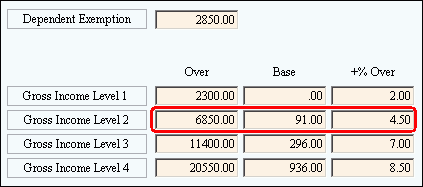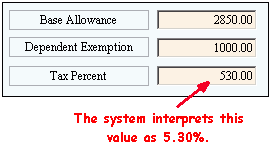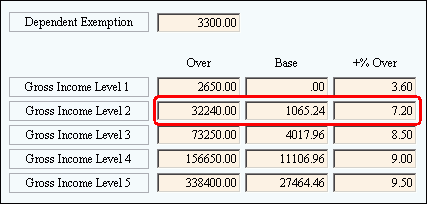To see the Federal Withholding Tax Calculation Example, click More.
Tip: The following Tax Tables are applicable for Federal withholding tax:
-
FEDM: Federal & Regular FICA for Married taxpayers
-
FEDS: Federal & Regular FICA for Single taxpayers
-
Federal & Medicare FICA Tax Table Maintenance (FEDM2 & FEDS2)
-
FEDM2: Federal & Medicare FICA for Married taxpayers
-
FEDS2: Federal & Medicare FICA for Single taxpayers
Tax Table Example:

If a single person's annual income is $25,000.00...
-
Gross Income Level = 2 (see table)
-
Federal Gross Income Over Amount = $10,000.00
-
Federal Base Amount to Withhold = $735.00
-
Federal Plus % of Excess Over Rate = 15.00%
-
$25,000.00 - $10,000.00 = $15,000.00 Excess Taxable Amount
-
Excess Taxable Amount $15,000.00 X % of Excess Over Rate 15.00% = Excess W/H Amount $2,250.00
-
Federal Tax Withholding Amount = $735.00 + $2,250.00 = $2,985.00
Notes:
-
To determine the withholding amount for the paycheck, divide the annual withholding amount by the number of pay periods in the year.
-
Matched Annuities amounts increase the Gross Pay for the calculation.
-
This example is meant to illustrate how the tax table fields are used. Actual tax rates, limits, and calculations may vary from this example according to current state formulas.





